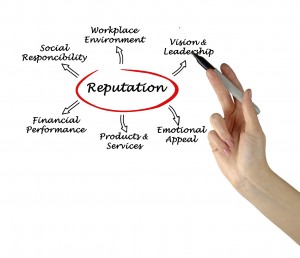I’ve heard some marketers say the role of PR was never really meant to build a brand but rather like a doctor taking the Hippocratic Oath, it is to do no harm to it. I’m not so sure I agree with that assessment. PR is inherently a tool for building a great reputation, and I believe a strong corporate reputation is increasingly a PR responsibility. PR grows the reputation to protect the brand.
Reputation—which can loosely be defined as trustworthiness—is not brand. Brand is image, while reputation is reality. Reputation is closer to reality. According to Dannielle Blumenthal, Ph.D., author and former editorial board member of the Journal of Brand Management, brand can be best conveyed by a consistent sales/marketing/advertising “core message,” whereas reputation is best conveyed by transparency. Now transparency, which is the real job of a public relations professional, means to tell the whole truth and nothing but the truth about the organization, and in so doing to portray the organization as trustworthy.
Reputation is a fundamental quality of every organization – what stakeholders believe about it, expect from it and say about it to others. But many businesses continue to manage their brands and reputations in separate silos. Reputation management, as I speak of it here, is the understanding or influencing of an individual’s or business’s reputation. It was originally coined as a public relations term, but advancement in the internet and social media has increasingly made it an issue of search results as well.
Reputation is rooted in what people know or think they know about an organization or an individual and what attitudes they hold based on that information.
Reputation is considered part of the social capital of a brand, something it can bank on and build on. [TWEET THAT!]
I would argue that reputation is perhaps the most important goal of any public relations program, and certainly one of the most vulnerable aspects of any organization. Thus the need to envision it, actively pursue it, and protect it at all cost. Some parts of reputation management are often associated with ethical grey areas, such as astroturfing review sites, censoring negative complaints or using SEO tactics to game the system and influence results.
Today’s strategic communications model of paid, owned and earned convergence of media, not to mention social, is the road map to successfully launching a brand or new product. Integrated marketing communications is also critical for a successful product launch. It involves the consistent communications of information about a product using communications channels and programs so that consumers get an effective message at the lowest cost. Channel examples include salespeople, advertising, public relations, sales promotions and publicity.
PR and strategic communications is no longer viewed as the stepchild of modern day marketing. Perhaps that’s because we live in a world of media hype where advertising has lost some of its power to influence. Today, more than ever, marketers are looking to launch new brands on the back of grassroots, word-of-mouth PR programs to create that one-of-a-kind sought-after buzz for the brand.
In essence, earned media has “earned” its place in today’s media model to launch and support a brand no matter how large or small. We create integrated communications campaigns that focus on earned media, social media and content. We zero in on building the business of our clients utilizing these methods to bolster reputations by:
- Making them industry leaders
- Driving consumer engagement
- Increasing market share
It’s also important to keep in mind that the mass economy has turned into the “customer economy” where customers talking to each other builds trust and PR plays a major role in that relationship. A good example of launching and sustaining a brand via PR channels was the work we did for the global UN Women campaign, HeForShe. Ogilvy PR had an opportunity to help redefine feminism by involving those with the most economic and social power – men.
We elevated the visibility of the official launch of the HeForShe campaign, led in part by UN Women Goodwill Ambassador, actress Emma Watson, as a solidarity movement for gender equality. Our campaign included robust social media outreach and a pre-launch promotion with an exclusive Associated Press story.
We were tasked with launching HeForShe globally to worldwide consumers—particularly men connected to social media. The primary obstacle was creating worldwide social media engagement through channels that had no following. The goal was to secure commitments from more than 100,000 men worldwide within the first two weeks. This had to be achieved without any paid promotion, while simultaneously executing an earned media program without access to the main spokesperson.
In the end, through Ogilvy PR’s strategic planning and real-time traditional and social media execution, the movement surpassed its goal and reached more than 169,000 men within two weeks of the launch. In addition, we went from virtually no social media presence to 4,241 YouTube comments, 14,709 Facebook comments and 1.1 million mentions of #HeForShe on Twitter, reaching 1.2 billion unique Twitter users!
Advertising may be the quickest way to tell a brand story to a large audience. But it is not enough. Savvy marketers look to integrated branding messaging through a number of channels, and more than ever, PR delivers major bang for the buck.



